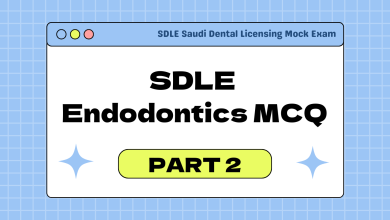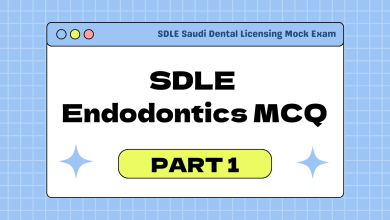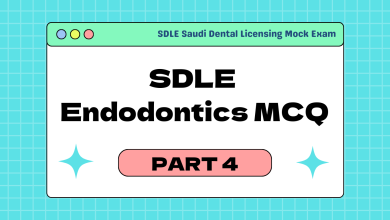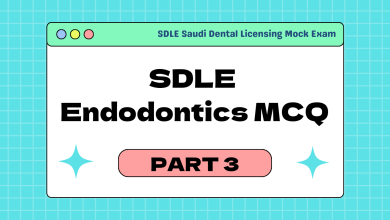Endodontics SDLE MCQ | Part 2

The Ultimate Guide to Conquering the SDLE: Your Strategic Blueprint for Success
Preparing for the SDLE exam is a significant milestone in every aspiring dentist’s career. It’s more than just a test of memorized facts; it’s a comprehensive assessment of your clinical judgment and deep understanding of various dental specialties. Many candidates feel overwhelmed by the vast amount of information, unsure of where to start or how to focus their efforts efficiently.
This in-depth guide is designed to be your roadmap. We will walk you through proven, strategic steps to build a robust study plan, choose the right topics, and approach the exam with the confidence needed to excel.
Part 1: The Art of Smart Topic Selection
One of the most common pitfalls in exam preparation is trying to learn everything at once. A strategic approach to selecting your study topics is not just helpful—it’s crucial for efficient and effective learning.
Why is Topic Selection a Game-Changer?
Your study time is your most valuable resource. Without a clear plan, you can easily spend hours on low-yield information while neglecting the foundational concepts that form the core of the exam. Intelligent topic selection ensures that every hour you invest brings you a higher return in knowledge and exam readiness.
Your Step-by-Step Strategy to Begin:
-
Start with Diagnosis in Every Major Subject.
Before diving deep into complex procedures, ground yourself in the diagnosis for each core specialty: Restorative (Resto), Endodontics (Endo), Prosthodontics (Pros), and Periodontics (Perio). This approach is powerful because it builds critical connections between the subjects. Since most exam questions are clinically-based, understanding how to diagnose a problem is the first and most essential step toward finding the correct solution. You’ll start to see the “big picture” of patient care. -
Identify and Master the Foundational Topics.
Every specialty has a set of fundamental principles that appear again and again. Your initial goal is not to become an expert in every rare condition, but to achieve complete mastery over these core topics. Think of it as building a strong skeleton; once that is in place, you can easily attach more detailed knowledge.
Part 2: Your Detailed Study Blueprint: What to Focus On
The SDLE exam is designed to test your basic knowledge, which means it consistently draws from a predictable set of high-yield topics within each specialty.
A Deep Dive into Key Specialties:
1. Restorative Dentistry
-
Diagnosis: The ICDAS System (International Caries Detection and Assessment System) is paramount. You must know it inside and out.
-
Classifications: Be thoroughly familiar with cavity classifications (Black’s, etc.).
-
Amalgam: Understand its phases, types of failures, and preparation design principles.
-
Partial Coverage: Differentiate clearly between inlays and onlays, including their indications and preparations.
Understanding ICDAS: A Practical Guide
ICDAS provides a standardized method for assessing caries. Here is a clear breakdown:
| Code | Description |
|---|---|
| 0 | Sound tooth surface |
| 1 | First visual change in enamel (seen only after drying) |
| 2 | Distinct visual change in enamel |
| 3 | Localized enamel breakdown without visible dentin |
| 4 | Underlying dark shadow from dentin |
| 5 | Distinct cavity with visible dentin |
| 6 | Extensive distinct cavity with visible dentin |
2. Endodontics
-
Diagnosis: Master pulp testing, percussion, palpation, and radiographic interpretation.
-
Materials: Know the composition, pH, and side effects of key materials like irrigants and sealers.
-
Surgical Procedures: Understand the indications and steps for an apicectomy.
-
Regeneration: Be clear on the indications and materials used in regenerative endodontics.
-
Files: This is a favorite area for examiners. Learn the colors, cross-sections, and specific properties of different file systems, especially hand files like K-files and H-files.
-
Rotary Systems: Understand the basic principles and safety protocols.
3. Periodontics
-
Diagnosis: Be fluent in both the old and new (2017) classification systems for periodontal diseases.
-
Probes: Know the different types of probes and their specific markings.
-
Periodontal Diseases: Understand the etiology and characteristics of gingivitis and various forms of periodontitis.
-
Instruments: Identify and know the uses of scalers, Gracey curettes, and water irrigation systems.
-
Maintenance: Understand the protocols for supportive periodontal care and re-evaluation.
Part 3: Mastering the Question Bank: A Strategic Tool, Not a Crutch
Many candidates use question banks, but few use them optimally. The key is to approach them after you have built a strong foundational knowledge.
How to Truly Leverage Old Questions to Your Advantage:
-
Look for Recurring Patterns. As you go through question sets, you will start to notice that certain topics are tested repeatedly. These are your high-yield areas. Keep a log of these topics and ensure you know them cold.
-
Study the Topic, Not Just the Question. Don’t just memorize the answer to a specific question. When you encounter a question about, for example, “Wharton’s tumor,” don’t just note that the answer is the submandibular gland. Instead, open your textbook and read the entire section on salivary gland tumors. This transforms a single question into a comprehensive learning session.
-
Always Cross-Reference with Reliable Sources. Your primary sources of information should be standard textbooks and current scientific literature. Use the question bank to identify gaps in your knowledge, and then fill those gaps with authoritative material.
-
Take Notes on Every Answer Choice. When reviewing a question, don’t just look at the correct answer. For every incorrect option, write down a brief note explaining why it is wrong. This active learning technique forces you to cover a much broader scope of information and deepens your understanding significantly.
-
Learn from Colleagues. Connect with peers who have recently taken the exam. They can provide valuable insights into the exam’s focus and atmosphere. However, filter this advice—everyone’s experience is subjective.
-
Answer Questions on Your Own First. Resist the temptation to immediately look at the answers. Challenge yourself to reason through the question independently. This builds critical thinking and problem-solving skills that are essential for the exam.
Part 4: Demystifying Exam Difficulty and Building Confidence
It’s natural to feel anxious, especially when you hear stories about “impossible” questions. Let’s reframe that thinking.
Are All the Questions Difficult? Absolutely Not.
Any well-constructed exam has a mix of easy, moderate, and difficult questions. The difficult ones are typically a small percentage, while the bulk of the exam consists of questions of easy to moderate difficulty. The psychological trap is that our brains tend to remember and talk about the challenging questions we faced. This creates a false impression that the entire exam was overwhelmingly hard.
The Takeaway: Don’t let post-exam stories from colleagues panic you. If you find a subject challenging, go back and solidify your basic understanding in that area. A strong foundation will allow you to confidently answer the majority of the questions.
Part 5: Essential Mindset and Final Takeaways for Success
Your preparation isn’t just about intellectual knowledge; it’s also about the right mindset and habits.
Your Success Mantra:
-
Invest Your Time Wisely. The exam is challenging but passable for those who are well-prepared. Consistent, focused study is an investment that will pay off immensely, not just for the exam but for your clinical career.
-
Rethink Study Groups. Avoid using study groups for initial learning. They often become inefficient social sessions. However, they can be excellent for final revision, quizzing each other, and discussing complex topics after you have done your individual studying.
-
Build an Unshakeable Foundation. Prioritize depth over breadth in your core subjects. A deep understanding of fundamental principles will allow you to deduce answers to questions you may not have directly studied.
-
Aim for Mastery, Not Just Passing. Go into the exam with the goal of truly understanding the material. This mindset shift reduces anxiety and fosters a more profound, long-lasting knowledge that will serve you far beyond the exam hall.
Examples of Endodontics SDLE MCQ
1. What is the primary cause of ledge formation during root canal instrumentation?
A. Excessive irrigation
B. Improper instrumentation technique
C. Use of small files
D. Inadequate anesthesia
Correct Answer: 2
Explanation: Improper instrumentation technique, such as using stiff files or failing to follow canal curvature, is the most common cause of ledge formation.
2. Which bacteria is most commonly associated with failed root canal treatments requiring retreatment?
A. Streptococcus mutans
B. Porphyromonas gingivalis
C. Enterococcus faecalis
D. Lactobacillus acidophilus
Correct Answer: 3
Explanation: Enterococcus faecalis is frequently isolated from teeth with persistent periapical lesions and is known for its resistance to conventional endodontic treatment.
3. What is the ideal obturation length for a root canal filling?
A. At the radiographic apex
B. 0.5–1.0 mm short of the radiographic apex
C. 2.0 mm beyond the apex
D. At the canal orifice
Correct Answer: 2
Explanation: The ideal obturation length is 0.5–1.0 mm short of the radiographic apex to ensure sealing without overextension.
4. Which of the following is the best solvent for gutta-percha removal during retreatment?
A. Xylene
B. Alcohol
C. Chloroform
D. EDTA
Correct Answer: 3
Explanation: Chloroform is highly effective at dissolving gutta-percha, facilitating its removal from the root canal system.
5. What is the recommended splinting time for a horizontal root fracture in the middle third?
A. 2 weeks
B. 4 weeks
C. 6 weeks
D. 8 weeks
Correct Answer: 2
Explanation: A splinting period of 4 weeks is generally recommended for horizontal root fractures to allow for adequate healing.
6. Which tooth is most likely to have a fourth canal (MB2) in the mesial root?
A. Mandibular first molar
B. Maxillary first molar
C. Maxillary second premolar
D. Mandibular canine
Correct Answer: 2
Explanation: The maxillary first molar frequently has a fourth canal (MB2) located palatally to the main mesio-buccal canal.
7. What is the main component of gutta-percha cones used in root canal obturation?
A. Zinc oxide
B. Resin
C. Calcium hydroxide
D. Glass ionomer
Correct Answer: 1
Explanation: Gutta-percha cones are composed primarily of zinc oxide, which provides the material’s plasticity and radiopacity.
8. Which irrigation solution is known for its ability to dissolve organic tissue?
A. Chlorhexidine
B. Saline
C. Sodium hypochlorite
D. Hydrogen peroxide
Correct Answer: 3
Explanation: Sodium hypochlorite is highly effective at dissolving necrotic tissue and biofilm, making it essential for cleaning root canals.
9. What is the management for a NaOCl accident during irrigation?
A. Reassure the patient and continue treatment
B. Administer local anesthesia, perform incision and drainage, and irrigate the area
C. Prescribe antibiotics and reschedule
D. Extract the tooth immediately
Correct Answer: 2
Explanation: Immediate management includes local anesthesia, incision and drainage to relieve pressure, and copious irrigation to dilute the NaOCl.
10. In which type of dental trauma does the tooth produce a high metallic sound on percussion?
A. Extrusion
B. Concussion
C. Intrusion
D. Avulsion
Correct Answer: 3
Explanation: An intruded tooth often produces a high metallic sound upon percussion due to its displacement into the alveolar bone.
Conclusion: Your Journey to Success Starts Now
The path to SDLE success is a marathon, not a sprint. It requires careful planning, disciplined execution, and a positive, resilient mindset. Start by strategically selecting your topics, build your knowledge layer by layer, and use practice questions as a diagnostic tool to refine your understanding.
Remember, confidence is born from competence. Every well-understood topic, every mastered concept, and every strategically studied hour brings you closer to your goal.
You have the capability and the resources to excel. Trust your preparation, stay focused on your plan, and walk into the exam ready to demonstrate your knowledge. Good luck







